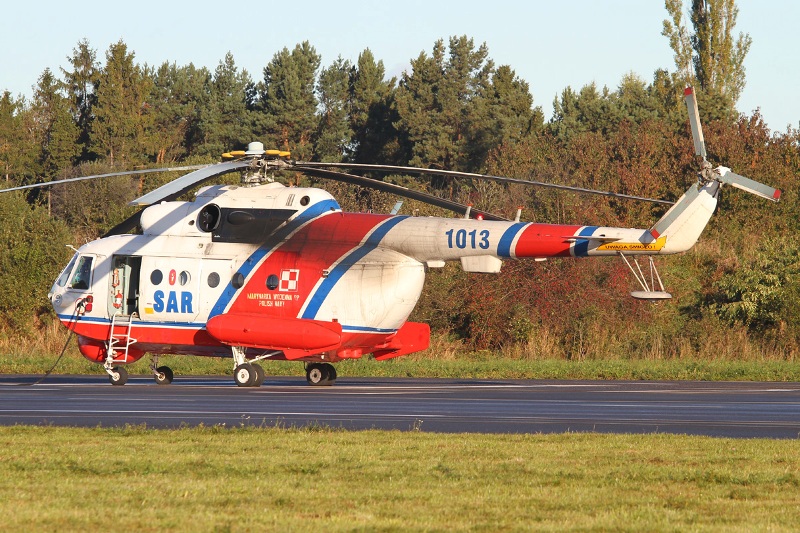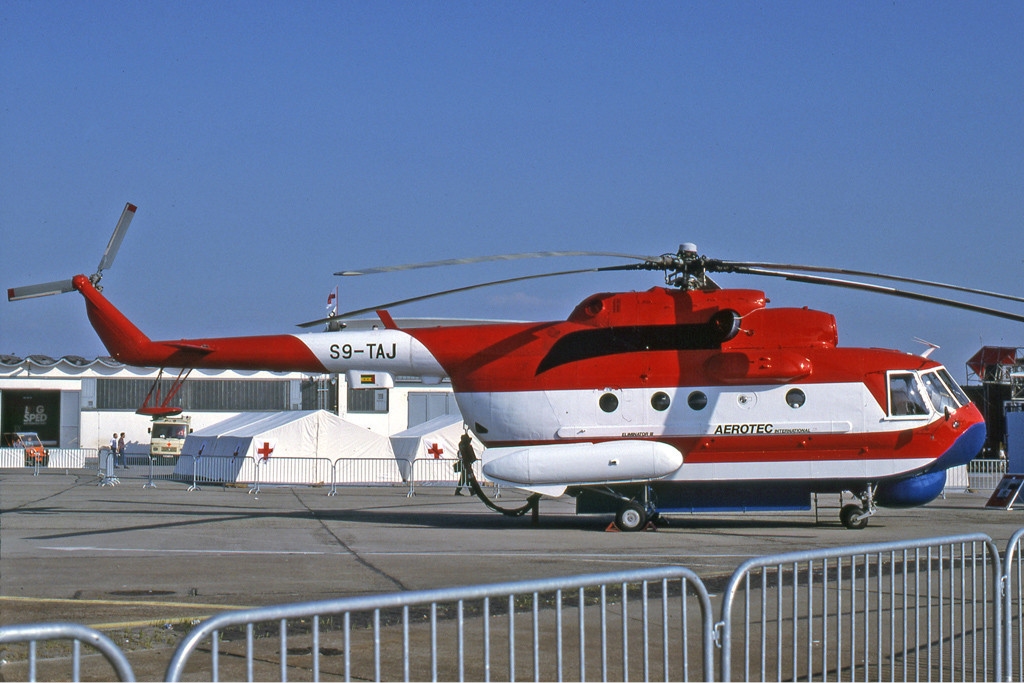Mil Mi-14PL on:
[Wikipedia]
[Google]
[Amazon]
The Mil Mi-14 (russian: Миль Ми-14,
 ;V-14
:Prototype of the Mi-14 helicopter.
;Mi-14PL (NATO Haze-A)
:Anti-submarine warfare helicopter, equipped with towed APM-60 MAD, OKA-2 sonobuoys and a retractable Type 12-M search radar, armed with either a single AT-1 or APR-2 torpedo, one ''Skat'' nuclear depth bomb or eight depth charges.Mladenov ''Air International'' March 2001, pp. 187–188. A single Mi-14PL was used to carry out trials with the
;V-14
:Prototype of the Mi-14 helicopter.
;Mi-14PL (NATO Haze-A)
:Anti-submarine warfare helicopter, equipped with towed APM-60 MAD, OKA-2 sonobuoys and a retractable Type 12-M search radar, armed with either a single AT-1 or APR-2 torpedo, one ''Skat'' nuclear depth bomb or eight depth charges.Mladenov ''Air International'' March 2001, pp. 187–188. A single Mi-14PL was used to carry out trials with the
 ;
*
;
* ;
* Korean People's Army Air Force
;
* Polish Navy
;
* Congolese Navy
;
* Syrian Air Force
;
* Korean People's Army Air Force
;
* Polish Navy
;
* Congolese Navy
;
* Syrian Air Force
 ;
* Ukrainian Naval Aviation
;
*
;
* Ukrainian Naval Aviation
;
*
 ;
* Ethiopian Air Force
;
* German Navy
;
*
;
* Ethiopian Air Force
;
* German Navy
;
*

Walkaround Mi-14PL (Kiev)
Mil Mi-14 page at Aviation.ru website
Robert Wasilewski Mil Mi-14 page
Mi-14 Photo Gallery
{{Authority control Amphibious helicopters Mil aircraft Anti-submarine helicopters 1960s Soviet anti-submarine aircraft 1960s Soviet helicopters Twin-turbine helicopters Aircraft first flown in 1969
NATO reporting name
NATO reporting names are code names for military equipment from Russia, China, and historically, the Eastern Bloc (Soviet Union and other nations of the Warsaw Pact). They provide unambiguous and easily understood English words in a uniform manne ...
: Haze) is a Soviet shore-based nuclear-capable amphibious anti-submarine
An anti-submarine weapon (ASW) is any one of a number of devices that are intended to act against a submarine and its crew, to destroy (sink) the vessel or reduce its capability as a weapon of war. In its simplest sense, an anti-submarine weapo ...
helicopter derived from the earlier Mi-8
The Mil Mi-8 (russian: Ми-8, NATO reporting name: Hip) is a medium twin-turbine helicopter, originally designed by the Soviet Union in the 1960s and introduced into the Soviet Air Force in 1968.
It is now produced by Russia.
In addition to ...
.
Design and development
Formal development of an anti-submarine warfare (ASW) version of theMil Mi-8
The Mil Mi-8 (russian: Ми-8, NATO reporting name: Hip) is a medium twin-turbine helicopter, originally designed by the Soviet Union in the 1960s and introduced into the Soviet Air Force in 1968.
It is now produced by Russia.
In addition t ...
transport helicopter was authorised by the Soviet Communist Party Central Committee and Council of Ministers in April 1965, with the objective of replacing the Mil Mi-4
The Mil Mi-4 (USAF/DoD reporting name "Type 36", NATO reporting name "Hound") is a Soviet transport helicopter that served in both military and civilian roles.
Design and development
The Mi-4 was designed in response to the American H-19 Chick ...
in the short-range, shore based anti-submarine role. The new helicopter was required to have an endurance of 2 hours on station at a radius of from base.Mladenov ''Air International'' March 2001, pp. 184–186.
The new design (with the internal designation V-14) differed from the Mi-8 in having a boat-like hull similar to the Sea King, allowing it to operate off the water, and a retractable four-point undercarriage, with the mainwheels retracting into large sponsons on the rear of the fuselage. The helicopter was to be powered by two Klimov TV3-117MT turboshaft engines. A watertight weapons bay is fitted to the centreline of the fuselage allowing internal carriage of a single torpedo or eight depth charges, while a radome housing a search radar is fitted beneath the nose.Gunston 1995, p. 238.
The Mi-14 has a crew of four: a pilot, a copilot, an onboard technician, and a weapon system operator. The Mi-14PL anti-submarine version is equipped with a radar, a dipping sonar and a magnetic anomaly detector.
The first prototype V-14, converted from a Mi-8 and powered by the older and less powerful Klimov TV2-117
The Klimov TV2-117 (initially Isotov TV2-117) is a Soviet gas-turbine turboshaft engine intended for helicopter use. Designed in the early 1960s by the Isotov Design Bureau the engine became the first purpose built gas turbine engine for helico ...
engines, flew on 1 August 1967. Development was slowed by problems with the helicopter's avionics and due to reliability problems with the TV3-117 engines, with production at Kazan not starting until 1973, and the helicopter (now designated Mi-14) entering service on 11 May 1976.
In January 2016, Russian Helicopters confirmed to Russian News Agency TASS that no final decision to revive production had been taken, but market demand, feasibility studies – including with Moscow's defence ministry – and funding sources were under review. The programme remains a “priority” for Russian Helicopters. The company suggested the Mi-14 would appeal to civil operators in Russia's far north and those supplying the oil and gas industry, alongside the nation's armed forces. Out of the almost 300 Mi-14s produced at Kazan Helicopters between 1973 and 1986, it is estimated that just 44 examples remain in active service.
Variants
Kh-23
The Zvezda Kh-66 and Kh-23 ''Grom'' (russian: Х-23 Гром 'Thunder'; NATO: AS-7 'Kerry') are a family of early Soviet tactical air-to-surface missiles with a range of 10 km. They were intended for use against small ground or naval targe ...
(NATO designation AS-7 Kerry) air-to-surface missile but this modification does not seem to have entered service.Mlandenov ''Air International'' March 2001, p. 188.
;Mi-14PLM
:Improved anti-submarine warfare version with Os'minog ASW suite, with new search radar, dipping sonar and digital computer. Limited use.Mladenov ''Air International'' April 2001, p. 244.
;Mi-14PŁ/R
:Polish conversion of two Mi-14PŁ (Polish designation for Mi-14PL) to search and rescue version, with ASW equipment removed, developed in 2010.Adam Gołąbek, Andrzej Wrona, ''Śmigłowce Mi-14PŁ/R w służbie'', in: Lotnictwo Nr. 7/2011, pp. 40–47 (in Polish).
;Mi-14BT (NATO Haze-B)
:Mine sweeping helicopter with ASW systems removed and equipped for towing Mine Countermeasures sleds. 25–30 built, with six exported to East Germany and two to Bulgaria.
;Mi-14PS (NATO Haze-C)
:Search and rescue version with search lights and sliding doors with hoist.Mladenov ''Air International'' April 2001, p. 245.
;Mi-14PX
:Search and rescue training helicopter for the Polish Navy (unofficial designation). One Polish Mi-14PŁ helicopter was temporarily converted into the Mi-14PX, then converted back in 1996.
;Mi-14PZh
:Amphibious firebuster version of Mi-14BT.Mladenov ''Air International'' April 2001, p. 246. Conversion price about USD1M.
;Mi-14GP
:Conversion of Mi-14PL to 24–26 seat civil passenger transport.
Operational history
As part of the Syrian civil war, starting from 2013, Syrian Navy Mi-14 helicopters were used as improvised bombers to drop naval mines and barrel bombs on large area targets from high altitude, mostly cities held by opposing forces. On 22 March 2015, one crashed with its pilot killed on the spot after capture and the rest of the crew captured. On 7 May 2022, Ukraine confirmed that Colonel Ihor Bedzay, the deputy head of the Ukrainian Navy, was killed when his Mi-14PS was shot down by a Russian Su-35. A video emerged, claimed shot on 7 May 2022, showing a Su-27 family fighter engaging a Mi-14 with its30 mm
30 mm caliber is a specific size of popular autocannon ammunition. Such ammunition includes NATO standard 30×113mmB and 30×173mm (STANAG 4624), Soviet 30×155mmB, 30×165mm, and 30×210mmB, Yugoslav 30×192mm, Anglo-Swiss 30×170mm, and ...
gun.
Operators
By 1991, about 230 had been delivered, with exports to many Soviet allies including Bulgaria, Cuba, East Germany, Libya, Poland, andSyria
Syria ( ar, سُورِيَا or سُورِيَة, translit=Sūriyā), officially the Syrian Arab Republic ( ar, الجمهورية العربية السورية, al-Jumhūrīyah al-ʻArabīyah as-Sūrīyah), is a Western Asian country loc ...
.Current operators
; *Georgian Air Force
The Aviation and Air Defence Command of the Defense Forces of Georgia, Defence Forces ( ka, თავდაცვის ძალების ავიაციისა და საჰაერო თავდაცვის სარდლო ...
 ;
*
;
*Libyan Air Force
The Libyan Air Force ( ar, القوات الجوية الليبية) is the branch of the Libyan Armed Forces responsible for aerial warfare. In 2010, before the Libyan Civil War, the Libyan Air Force personnel strength was estimated at 18,000 ...
 ;
* Korean People's Army Air Force
;
* Polish Navy
;
* Congolese Navy
;
* Syrian Air Force
;
* Korean People's Army Air Force
;
* Polish Navy
;
* Congolese Navy
;
* Syrian Air Force
 ;
* Ukrainian Naval Aviation
;
*
;
* Ukrainian Naval Aviation
;
*Yemen Air Force
The Yemeni Air Force ( ar, القوات الجوية اليمنية, al-Quwwat al-Jawwiya al-Yamaniya) is the air operations branch of the Yemeni Armed Forces. Numbers of aircraft can not be confirmed but serviceability of these aircraft is low. ...
Former operators
; * Bulgarian Navy ; * Cuban Air Force ; * East German Navy ;
* Ethiopian Air Force
;
* German Navy
;
*
;
* Ethiopian Air Force
;
* German Navy
;
*Russian Naval Aviation
The Russian Naval Aviation ( rus, Авиация Военно-морского флота России, r=Aviatsiya Voenno-morskovo Flota Rossii) is the air arm of the Russian Navy, a successor of Soviet Naval Aviation. The Russian Navy is divide ...
;
* People's Democratic Republic of Yemen Air Force
;
* Soviet Naval Aviation
;
* Yugoslav Air Force
Specifications (Mi-14PL)
See also
References
Notes
Citations
Bibliography
* Gunston, Bill. ''The Osprey Encyclopedia of Russian Aircraft 1875–1995''. London: Osprey, 1995. . * Mladenov, Alexander. "Cutting through the Haze". ''Air International'', March 2001, pp. 184–188. ISSN 0306-5634. * Mladenov, Alexander. "Cutting through the Haze: Part 2". ''Air International'', April 2001, pp. 244–247. ISSN 0306-5634.External links
Walkaround Mi-14PL (Kiev)
Mil Mi-14 page at Aviation.ru website
Robert Wasilewski Mil Mi-14 page
Mi-14 Photo Gallery
{{Authority control Amphibious helicopters Mil aircraft Anti-submarine helicopters 1960s Soviet anti-submarine aircraft 1960s Soviet helicopters Twin-turbine helicopters Aircraft first flown in 1969